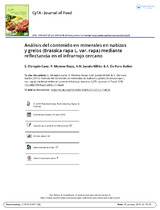Análisis del contenido en minerales en nabizas y grelos (Brassica rapa L. var. rapa) mediante reflectancia en el infrarrojo cercano
Analysis of mineral content in turnip greens and turnip tops (Brassica rapa L. var. rapa) by near-infrared reflectance spectroscopy
Autor
Obregón Cano, Sara
Moreno Rojas, Rafael
Jurado-Millán, A.M.
Haro Bailón, Antonio de
Editor
Taylor & FrancisFecha
2015Materia
Brassica rapaNIRS
Potassium
Calcium
Phosphorus
Magnesium
Sodium
Iron
Zinc
Manganese
Copper
Potasio
Calcio
Fósforo
Magnesio
Sodio
Hierro
Manganeso
Cobre
METS:
Mostrar el registro METSPREMIS:
Mostrar el registro PREMISMetadatos
Mostrar el registro completo del ítemResumen
The objective of this study was to evaluate the potential and accuracy of near-infrared reflectance spectroscopy (NIRS) for predicting the
mineral content in lyophilized samples of turnip greens and turnip tops (Brassica rapa L. var. rapa). Mathematical treatments of the spectra
and modified partial least squares regression (MPLS) were used for developing calibrations equations (n = 298). An independent set of
samples (n = 69) was used to evaluate and validate the performance of the calibrations equations. The coefficients of determination obtained
in the external validation (r2
ev) and error of prediction (SEP) for the different minerals were K = 0.86 (SEP = 4,90), Ca = 0.91 (SEP = 1,66),
P = 0.73 (SEP = 0,86), Mg = 0.85 (SEP = 0,32), Na = 0.87 (SEP = 0,21), Fe = 0.90 (SEP = 60,48), Zn = 0.80 (SEP = 5,83), Mn = 0.81
(SEP = 5,72) and Cu = 0.62 (SEP = 1,13).The calibration equations obtained for Ca and Fe showed the highest predictive ability These
results support the idea that NIRS technology is suitable for the fast, non-destructive, and accurate prediction of mineral content in turnip
greens and turnip tops. El objetivo de este trabajo fue la evaluación del potencial de la espectroscopía de reflectancia en el infrarrojo cercano (NIRS) para el análisis
del contenido mineral en muestras liofilizadas de nabizas y grelos (Brassica rapa L. var. rapa). Se aplicó el método de mínimos cuadrados
parciales modificados (MPLS) para desarrollar ecuaciones de calibración (n=298). Se evaluó la capacidad predictiva de las ecuaciones de
calibración obtenidas mediante un lote de muestras (n=69) independientes del colectivo de calibración. Los coeficientes de determinación
(r2
ve) y errores de predicción (SEP) obtenidos en la validación externa para los distintos minerales fueron K=0,86(SEP=4,90); Ca=0,91
(SEP=1,66); P=0,73(SEP=0,86); Mg=0,85(SEP=0,32); Na=0,87(SEP=0,21); Fe=0,90(SEP=60,48); Zn=0,80(SEP=5,83); Mn=0,81
(SEP=5,72)y Cu=0,62(SEP=1,13). Las ecuaciones para Ca y Fe fueron las que mostraron mayor capacidad predictiva. Estos resultados
demuestran el potencial del NIRS para el análisis rápido, no destructivo y preciso del contenido mineral en nabizas y grelos.

